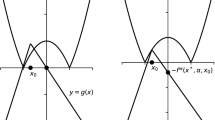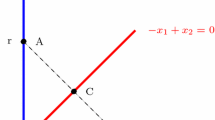Abstract
In this paper, we present a necessary and sufficient condition for a zero duality gap between a primal optimization problem and its generalized augmented Lagrangian dual problems. The condition is mainly expressed in the form of the lower semicontinuity of a perturbation function at the origin. For a constrained optimization problem, a general equivalence is established for zero duality gap properties defined by a general nonlinear Lagrangian dual problem and a generalized augmented Lagrangian dual problem, respectively. For a constrained optimization problem with both equality and inequality constraints, we prove that first-order and second-order necessary optimality conditions of the augmented Lagrangian problems with a convex quadratic augmenting function converge to that of the original constrained program. For a mathematical program with only equality constraints, we show that the second-order necessary conditions of general augmented Lagrangian problems with a convex augmenting function converge to that of the original constrained program.
Similar content being viewed by others
References
D.P. Bertsekas (1982) Constrained Optimization and Lagrange Multiplier Methods Academic Press New York
A. Ben-Tal J. Zowe (1982) ArticleTitleA unified theory of first-order and second-order conditions for extremum problems in topological vector spaces Mathematical Programming Study 19 39–76
A. Ben-Tal J. Zowe (1982) ArticleTitleNecessary and sufficient conditions for a class of nonsmooth optimization problems Mathematical Programmming 24 70–91
G.B. Dantzig J. Folkman N. Shapiro (1967) ArticleTitleOn continuity of the minimum set of a continuous function Journal of Mathematical Analysis and Applications 17 519–548
Di Pillo, G. and Grippo, L. (1982), An augmented Lagrangian for inequality constraints in nonlinear programming problems, Journal of Optimization Theory and Applications, 495–519.
G. Di Pillo S. Lucidi (1996) On exact augmented Lagrangian functions in nonlinear programming G. Di Pillo F. Giannessi (Eds) Nonlinear Optimization and Applications Plenum Press New York 85–100
G. Di Pillo S. Lucidi (2001) ArticleTitleAn augmented Lagrangian function with improved exactness properties SIAM Journal on Optimization 12 376–406
O. Guker (1992) ArticleTitleAugmented Lagrangian algorithms for linear programming Journal of Optimization Theory and Applications 75 445–470
X.X. Huang X.Q. Yang (2003) ArticleTitleA unified augmented Lagrangian approach to duality and exact penalization Mathematics of Operations Research 28 533–552
Mustafa C. Pinar (1999) ArticleTitleA characterization of optimal set of linear programs based on the augmented Lagrangian Journal of Information and Optimization Sciences, 20 299–308
R.T. Rockafellar (1954) ArticleTitleAugmented Lagrangian multiplier functions and duality in nonconvex programming SIAM Journal on Control and Optimization 12 268–285
R.T. Rockafellar (1993) ArticleTitleLagrangian multipliers and optimality SIAM Review 35 183–238
R.T. Rockafellar R.J.-B. Wets (Eds) (1998) Variational Analysis Springer-Verlag Berlin
A.M. Rubinov B.M. Glover X.Q. Yang (1999) ArticleTitleModified Lagrangian and penalty functions in continuous optimization Optimization, 46 327–351
A.M. Rubinov X.X. Huang X.Q. Yang (2002) ArticleTitleThe zero duality gap property and lower semicontinuity of the perturbation function Mathematics of Operations Research 27 775–791
Teo, K.L., Goh, C.J. and Wong, K.H. (1991), A Unified Computational Approach to Optimal Control Problems, Longman Scientific and Technical.
S.J. Wright (1990) ArticleTitleImplementing proximal point methods for linear programming Journal of Optimization Theory and Applications, 65 531–551
X.Q. Yang X.X. Huang (2001) ArticleTitleA nonlinear Lagrangian approach to constrained optimization problems SIAM Journal on Optimization, 11 1119–1144
X.Q. Yang (1996) ArticleTitleOn second-order directional derivatives Nonlinear Analysis, Theory, Methods and Applications 26 55–66
X.Q. Yang (1998) ArticleTitleSecond-order global optimality conditions for convex composite optimization Mathematical Programming, 81 327–347
Author information
Authors and Affiliations
Corresponding author
Additional information
This research is supported by the Research Grants Council of Hong Kong (PolyU B-Q359.)
Rights and permissions
About this article
Cite this article
Huang, X.X., Yang, X.Q. Further Study on Augmented Lagrangian Duality Theory. J Glob Optim 31, 193–210 (2005). https://doi.org/10.1007/s10898-004-5695-7
Received:
Accepted:
Issue Date:
DOI: https://doi.org/10.1007/s10898-004-5695-7




